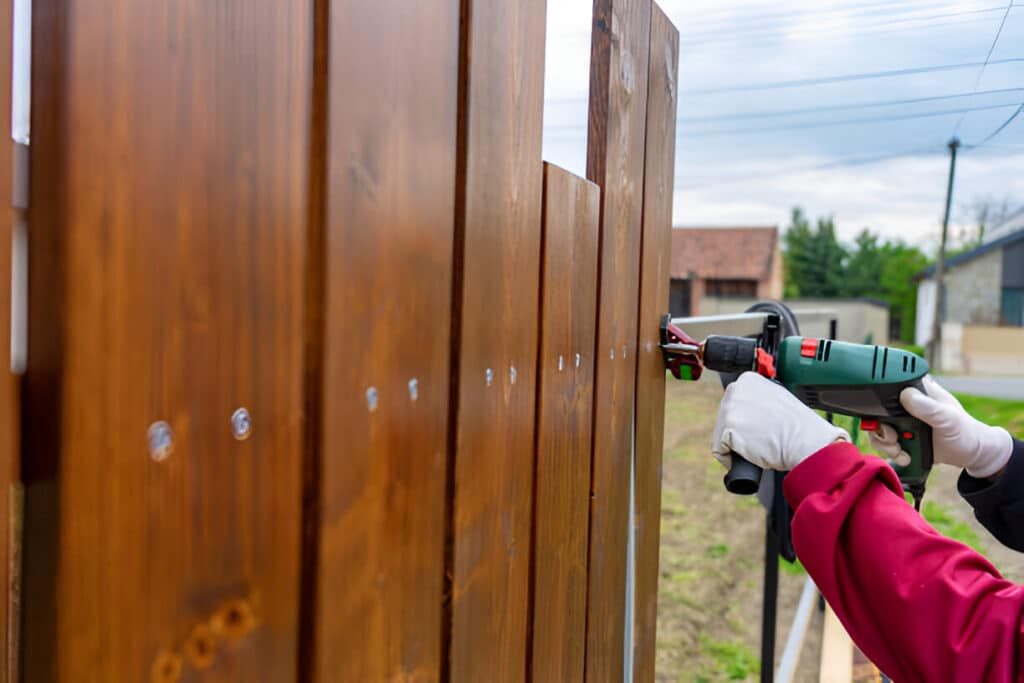When planning a fence installation, understanding the factors that influence costs is crucial. At Liberty Fence & Supply, we guide customers through these considerations to find the ideal fencing solution for their needs and budget. This blog post explores the top five factors affecting fence installation costs, helping you make an informed decision for your property.
Fencing Material
The choice of fencing material significantly impacts installation costs. Each material offers unique benefits and price points:
Wood fencing: A classic option, wood fencing is affordable, especially cedar or pine. Costs rise with premium woods like redwood. Wood fences provide a natural look but need regular maintenance to prevent rot and insect damage.
Vinyl fencing: Initially more expensive than wood, vinyl offers durability and low maintenance, saving money over time. Resistant to weathering, it doesn’t require painting or staining, appealing to those seeking a low-maintenance option.
Chain-link fencing: The most cost-effective choice, chain-link fencing is durable and requires minimal upkeep, ideal for budget-conscious buyers. However, it may lack privacy and aesthetic appeal compared to other materials.
Aluminum fencing: A mid-range option, aluminum offers durability and a sleek appearance. Resistant to rust, it requires minimal maintenance and can mimic wrought iron’s look without the cost and upkeep.
Wrought iron fencing: The most expensive, wrought iron provides elegance and strength but requires regular maintenance. Chosen for its classic look, it enhances property value but needs painting to prevent rust.
At Liberty Fence & Supply, we offer a range of materials to suit various preferences and budgets, ensuring you find the perfect match for your property.
Fence Length and Height
The size of your fence is crucial in determining installation costs:
Measuring your property: Accurate measurements are essential for cost estimation. Our team can help determine the exact length needed, ensuring you purchase the right amount of materials without waste.
Impact of fence height on cost: Taller fences require more materials and labor, increasing costs. Standard residential heights range from 4 to 8 feet, but taller fences for privacy or security will impact the budget.
Considering local regulations: Check local zoning laws and homeowners’ association rules on fence height restrictions. Non-compliance can lead to fines or alterations, adding unexpected costs.
Terrain and Landscape
Property characteristics significantly impact installation costs:
Flat vs. sloped land: Installing on flat terrain is less expensive than on slopes, which may need additional materials and labor for leveling. Sloped areas might require stepped or contoured fencing, increasing complexity and cost.
Obstacles and obstructions: Trees, rocks, and landscaping features may need removal, increasing costs. Clearing obstacles requires additional labor and equipment, impacting the budget.
Soil type and condition: Rocky or clay-heavy soil complicates post-hole digging, affecting labor costs. Special equipment or techniques may be necessary for secure installation.
Liberty Fence & Supply has experience with various terrain types, ensuring a smooth installation process regardless of your property’s characteristics.
Labor Costs
The installation process significantly contributes to overall costs:
Professional installation vs. DIY: DIY can save money but requires time, effort, and expertise. Professional installation ensures proper technique and may be more cost-effective long-term, reducing error risks that lead to costly repairs.
Regional labor rates: Labor costs vary by location and demand for fencing services. High demand for skilled labor can increase rates, impacting your budget.
Complexity of the project: Intricate designs, challenging terrain, or custom features increase labor costs due to additional time and skill required. Unique designs or specialized skills naturally incur higher expenses.
Our experienced team at Liberty Fence & Supply provides efficient, high-quality installation services to ensure your fence is correctly installed and built to last.
Additional Features and Customization
Personalizing your fence enhances functionality and appeal but may impact costs:
Gates and entry points: The number and type of gates affect total costs. Automatic gates or those with special features are more expensive than standard manual gates. Consider convenience and security needs when selecting gate options.
Decorative elements: Adding lattice tops, post caps, or decorative features increases material and labor costs. These elements enhance visual appeal, making your fence a standout feature.
Staining or painting: For wood fences, applying stain or paint for protection and aesthetics adds to costs. Regular maintenance, like repainting or restaining, preserves appearance and longevity.
Post caps and finials: These finishing touches enhance the look but contribute to expenses. They offer personalization and add elegance or uniqueness.
At Liberty Fence & Supply, we offer customization options to help create the perfect fence for your property. Our team is dedicated to achieving the ideal balance between functionality, aesthetics, and budget.
Understanding these factors helps you make informed decisions when planning your fence installation. While cost is important, choosing a fence that meets privacy, security, and aesthetic needs is crucial. A well-chosen fence enhances property value and provides peace of mind.
Ready to start your fence installation project? Contact Liberty Fence & Supply today at (928) 537-3333 for a free consultation and estimate. Our experienced team will guide you through the process, helping you choose the best fencing solution for your property and budget. We are committed to delivering quality and satisfaction, ensuring your new fence meets all your expectations.

